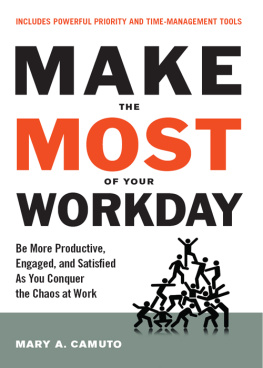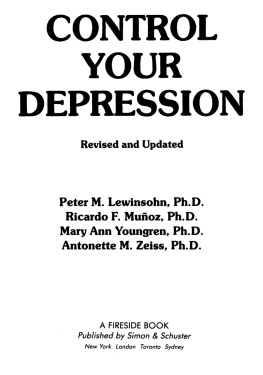
Workday Mastery Toolkit
It has been a long and productive journey, hasnt it? Youve learned quite a range of ideas, concepts, and tools, all on the road to Workday Mastery. In this book, you have spanned the three layers of the Workday Mastery Pyramid: a Control layer for vanquishing chaos and gaining order in your day; a Create layer for visioning and creating your goals; and a Connect layer for transforming your work into a calling that matches who you really are. These three layers build on one another.
You also learned an overarching solution frameworkthat of your Workday Nowemphasizing how knowledge of a simple mental model can help you to improve your entire workday experience.
As a wrap-up, in addition to the ideas weve discussed in the book, I want to give you a summary in one place of all the tools you need to put these ideas into practice. The tools naturally align with the three parts of the book, so that is how you will see them here.
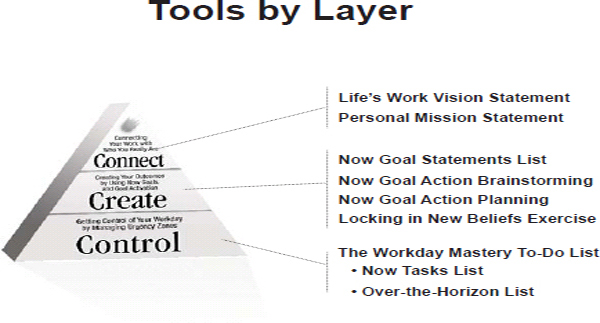
Tools from Part I: Controlling Your Workday Now
On the next two pages are the two main components of the Workday Mastery To-Do List you learned in Part Ithe Now Tasks List and the Over-the-Horizon List. Recall that three levels of this to-do list were presented in Part I; the samples shown here match the most complete one, Level 3. Downloadable blank templates (including MindManager versions) are available at my website, MasterYourWorkday.com/ToolDownloads.
Now Tasks List
As you may recall, the Now Tasks list is a form showing a one-page list of all the tasks you need to be thinking about in your workday. It was introduced in Chapter 2 and expanded on in later chapters. By the end of Part I the Now Tasks list included three urgency zones: Critical Now, Opportunity Now, and Target Now (all covered in Chapter 6), as well as the Significant Outcomes section at the top (discussed in Chapter 7).
Here is a sample of the full Now Tasks List (from the Level 3 templates), with notes on how to use each section on the form.
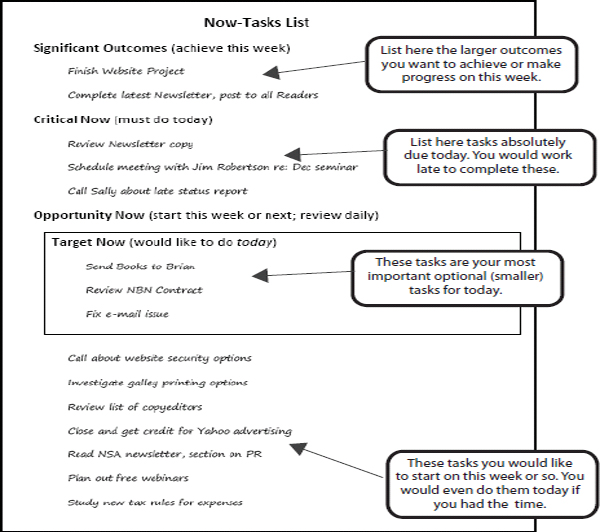
Over-the-Horizon List for Defer-to-Review Tasks
In Chapter 6 you learned about the Strategic Deferral process, and specifically, Defer-to-Review tasks. You put Defer-to-Review tasks on the Over-the-Horizon pages. At its simplest, you use one page that you review weekly. Better, though, is to use the Level 3 templates, which include five additional pages to support the extended-review-cycle approach; that is shown below. As you can see, each added page has a longer review cycle.
Here is a sample of a completed Level 3 set, with notes indicating the optional pages.
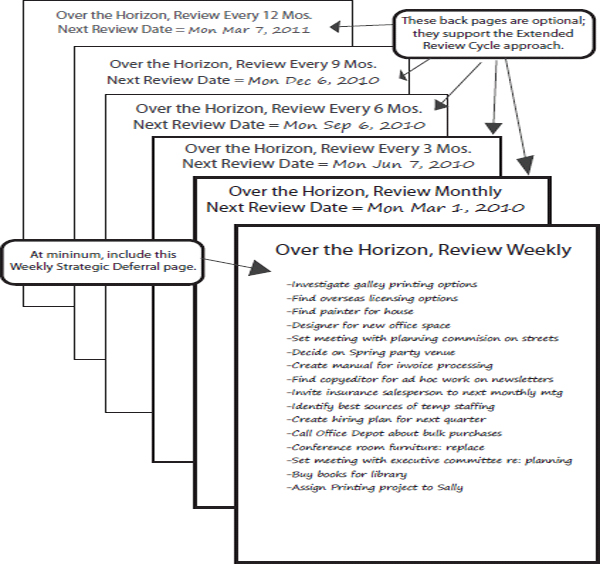
Tools from Part II: Creating Your Workday Now
In Part II: Creating Your Workday Now, you learned how to create Now Goals. Most of Part II was dedicated to the 4-step Now Goal creation process. Here are the four steps again.
Step 1: Create your Vision Goal. As you know by now a Vision Goal is essential. I showed you in Chapter 10 a simple formula to create it.
Step 2: Identify your Target Goals and add them to the Vision Goal. Nearly all goals need a Target Goal component, and Chapter 11 showed some fine points on adding them. Once youve added them, you will have the two core pieces of your new Now Goal statement.
Step 3: Activate the Now Goal. This is just as important as writing a good Now Goal statement, and the most important ongoing step after initially creating the goal. Chapter 12 presented a thorough explanation of why it was needed and how to do it.
Step 4: Take first action. This is where you start to engage your goal. Chapter 13 covered how to do that. One option is to brainstorm a few actions for each goal, ideally using a mind map. Another option, for larger goals, is to create a small project plan (timeline).
At the end of these steps you typically ended with a list of Now Goal statements, which you activated all in one sitting. And Chapter 14 provided you with an optional exercise to help expand your beliefs about what you are able to accomplish, to help you set your sights on tougher goals.
On the pages that follow are samples of a Now Goal statements list, a first action brainstorming list, and a project plan, as well a sample Locking in New Beliefs statement and a generic list you can use in creating your own Locking in New Beliefs statement.
The Now Goal samples below were created using MindManager software, which I discuss in Chapter 13. However, you could create these in nearly any word processing application, or by hand. Templates for MindManager and Microsoft Word are included on my website, MasterYourWorkday.com/ ToolDownloads.
Now Goal Statements List
It is helpful to list all your smaller goals on one page so that you can activate them one after the other. One idea presented in Chapter 11 was to recreate this list each season with new goals you are working on and hope to complete that season. Here is a sample of one such page.
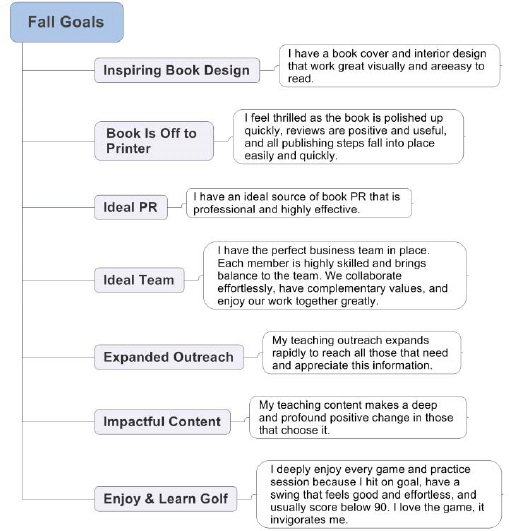
Now Goal Action Brainstorming
In Chapter 13 I discussed optionally brainstorming actions. Here is one way that might look using the same goal form as above, just adding some action topics to the right of the goal.

Now Goal Action Planning
In Chapter 13 I also discussed optionally creating a project plan (timeline) for the steps of a much larger goal. Here is how that might look. I used the optional JCVGantt add-in module for MindManager to convert the MindManager topics directly into a linked project schedule. You can of course use any application that creates timelines, like Microsoft Project, or even manually create a timeline in a graphics application or Microsoft Excel.

Locking in New Beliefs Example
Chapter 14 in Part II was about expanding your beliefs such that you can take on bigger goals. I showed you how to create a list of ways that your Workday Now and personal life might change once those new beliefs or goals were in place. Reviewing that list daily during your goal activation process helps your subconscious embrace your larger capabilities.
Here is a sample of one such page.
1. My paycheck: Nicely larger this month!
2. My calendar or time: My clients are calling me, wanting to buy. I have sales meetings with them scheduled on my calendar. I have many closing meetings scheduled on my calendar. (Picture that.)
3. Attitude of my boss to me: Ted, good jobkeep it up. You are an example to all of us!
4. Comments from my colleagues: Wow, Ted, whats your secret? Can you show me how to do some of this?
5. Conversations I have with most others about the new success: Yeah, sales are good. My contacts are all paying off. Most of my calls are closing; people just seem to want to do business with me. You guys can do this toojust envision how you want your sales to go, and then do the work.
Next page

